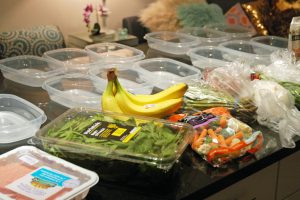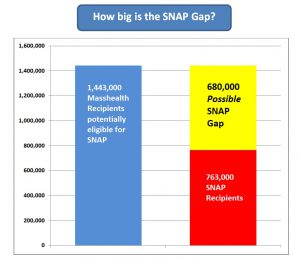 Eating healthy on a limited budget requires thinking outside the box – and not just the mac and cheese box. That’s why you won’t find the usual “healthy eating tips” that you can find in any newspaper or magazine. We’re not going to tell you to plan your menus and buy in-season fresh fruits and veggies – though those are great tips. We understand that when you’re stretching your budget AND your time, there are lots of challenges that make it harder to eat healthy. That’s why we’re thinking outside the box and offering tips and suggestions that you won’t find on most National Nutrition Month tip sheets.
Eating healthy on a limited budget requires thinking outside the box – and not just the mac and cheese box. That’s why you won’t find the usual “healthy eating tips” that you can find in any newspaper or magazine. We’re not going to tell you to plan your menus and buy in-season fresh fruits and veggies – though those are great tips. We understand that when you’re stretching your budget AND your time, there are lots of challenges that make it harder to eat healthy. That’s why we’re thinking outside the box and offering tips and suggestions that you won’t find on most National Nutrition Month tip sheets.
Here’s the thing. When you’re poor, eating healthy isn’t just about buying the right foods. There’s a good chance that you don’t have access to a car or a supermarket close enough to walk to. If you’re working more than one job – and many of us have to in order to cobble together a full-time income – you don’t have time to do elaborate meal planning and prep. And when you do have time, you’d much rather spend it with your family than putting up meals to put away for later cooking. These resources and ideas can help you stretch your budget and get healthier foods onto your family’s dinner table.
- Apply for SNAP

Source: Massachusetts Law Reform Institute - Nearly half the people who are likely eligible for SNAP do not receive SNAP benefits. Are you one of them? There are lots of reasons people don’t apply for SNAP, and one very good reason why you should: SNAP benefits help you feed your family. The results stretch far beyond fewer tummy rumbles. Medical research shows that kids in families who receive SNAP benefits get more vitamins, have lower risks of anemia and obesity, and do better in school.
- The Massachusetts Law Reform Institute has calculated that the SNAP Gap in Massachusetts is 47% – about half the people who likely qualify for SNAP don’t receive benefits. That could include as many as 680,000 people statewide. Here in Worcester and surrounding towns, the SNAP Gap ranges from 23% to 77%. You can check out the SNAP Gap by zip code in this interactive SNAP Gap map. You can apply for SNAP online or print and fill out a paper application for SNAP and mail it in. The amount you qualify for depends on your income and family size, but every little bit helps when you’re trying to stretch your budget.
- Talk to Your Doctor
- In 2014, UMass Memorial Medical Center started the Farm-to-Health Center Initiative, a program that provided fresh vegetables each week to families at high risk of food insecurity. One of the main goals of the program was to get doctors to talk to their patients about food insecurity. Over the years, there have been a number of programs that provided access to healthy food through doctors, including the UMass program and the Fruit and Vegetable Prescription Program. As a result, many doctors will now ask patients about whether they always have enough food in the house, and offer resources that may include a list of food pantries, recipes for healthy cooking, or, in some cases, coupons that can be used to buy fresh produce. Because these programs depend on funding, they’re not always available, but if your doctor asks if you sometimes run out of food between paychecks, be honest. They may be able to help.
- Shop with a Friend
- Lack of transportation is one of the biggest reasons that families spend more money on food. When they can’t get to a supermarket, where prices are lower, they often rely on nearby convenience stores for daily necessities. A supermarket trip on public transportation can take the better part of a day, thanks to the WRTA schedule, and the amount of food you can buy in one trip is limited to what you can carry on the bus. A cab ride can add as much as $20 to your “grocery bill” – and that has to be paid in cash. One way to reduce that cost and cut your food costs is to team up with one or more neighbors and share a ride. If you’re lucky enough to own a car, offer to take a friend with you when you shop. If you don’t, try to work out a ride share. Even if you cab it to the supermarket, splitting the cost of the cab can make it more affordable – and more fun.
- Cook with Your Village Stone Soup Style
- “Cook ahead for the week.” It’s one of the most popular busy-mom tips for a reason – when you’ve got meals prepped for the week, you’re much more likely to eat healthier foods. It also can be especially difficult to do when you’re feeding your family on a tight budget, or when your free time is already squeezed to the max. One way to manage it is to turn food prep into a social occasion. Invite a couple of friends to join you, and split the ingredients for several meals among you. You can hang out together in the kitchen, chopping vegetables and bagging meals (wine optional!) while you catch up with each other and the kids play. At the end of the afternoon, you all go home with several “convenience” meals that are healthier than prepackaged food. Here are a few resources to help you plan:
- 16 Easy Recipes for Cooking Ahead
- A Week of Five-ingredient Dinners for Less than $50
- Sunday Prep School – Two Hours to A Week’s Worth of Meals



